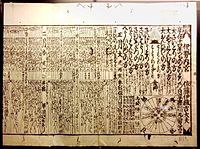Japanese calendar

The Japanese calendar is a way of keeping track of time in Japan. It is different from the calendar used in other countries because it counts years in a unique way.
The Japanese calendar starts with the year of the founding of Japan, which is said to be 660 BC. So, the first year in the Japanese calendar is called Kōki 1 (紀元1). Kōki means "era year."
After that, each era in Japanese history has its own name and the years are counted from the start of that era. For example, the current era is called Reiwa (令和) which started on May 1, 2019, when Emperor Naruhito became the new emperor of Japan after his father, Emperor Akihito, abdicated the throne. So, the current year is Reiwa 3 (令和3).
The Japanese calendar also has special names for each month. For example, January is called "Mutsuki" (睦月) which means "month of harmony."
The dates in the Japanese calendar are often written using both the Japanese and Western numerals. For example, the date "January 1, 2021" would be written in Japan as "令和3年1月1日" or "Reiwa 3-nen 1-gatsu 1-nichi."
The Japanese calendar is important because it is used for official documents and events in Japan, such as the emperor's ascension to the throne, national holidays, and traditional events.
The Japanese calendar starts with the year of the founding of Japan, which is said to be 660 BC. So, the first year in the Japanese calendar is called Kōki 1 (紀元1). Kōki means "era year."
After that, each era in Japanese history has its own name and the years are counted from the start of that era. For example, the current era is called Reiwa (令和) which started on May 1, 2019, when Emperor Naruhito became the new emperor of Japan after his father, Emperor Akihito, abdicated the throne. So, the current year is Reiwa 3 (令和3).
The Japanese calendar also has special names for each month. For example, January is called "Mutsuki" (睦月) which means "month of harmony."
The dates in the Japanese calendar are often written using both the Japanese and Western numerals. For example, the date "January 1, 2021" would be written in Japan as "令和3年1月1日" or "Reiwa 3-nen 1-gatsu 1-nichi."
The Japanese calendar is important because it is used for official documents and events in Japan, such as the emperor's ascension to the throne, national holidays, and traditional events.
Related topics others have asked about:
